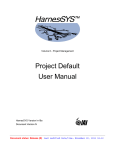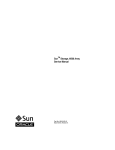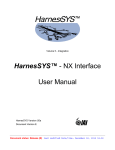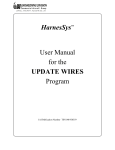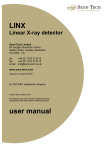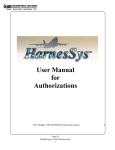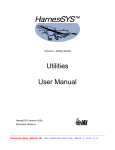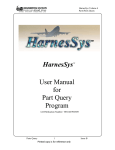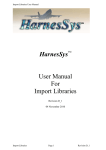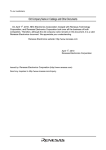Download Manufacturing Documents
Transcript
HarnesSYS TM User Manual for MANUFACTURING HarnesSys volume 7 Manufacturing 2 Notices The information contained in this manual is believed to be accurate and reliable. However, Israel Aerospace Industries Ltd. (IAI) assumes no responsibility for any errors, omissions, or inaccuracies whatsoever. Information in this document is subject to change without notice and does not represent a commitment on the part of Israel Aerospace Industries Ltd. (IAI). The software and/or data base described in this document are furnished under a license and/or agreement. The software and/or data base may be used or copied only in accordance with the terms of such license and/or agreement. It is against the law to copy the software on any medium except as specifically allowed in the license and/or nondisclosure agreement. The purchaser may make one copy of the software for backup purposes. No part of this document and/or data base may be reproduced or transmitted in any form or by any means, electronic or mechanical, including photocopying, recording, or information storage and retrieval systems, for any purpose other than the purchaser’s personal use, without the express written permission of IAI. 2007 Israel Aerospace Industries Ltd. All rights reserved. Pub. Number TSN140/930394 Issue B Revision 0 Prepared by Printed for reference only Version 16.00 Table of contents 3 Table of Contents Introduction ............................................................................................................................ 5 Documents required for Manufacturing: ............................................................................ 5 2D Routing Diagrams..................................................................................................... 5 Jig (or Form Board) Diagrams ....................................................................................... 5 Build-to-Package (BTP) Documents .............................................................................. 5 Manufacturing Build-to-Package Documents (MBTP).................................................. 6 Manufacturing Operations.................................................................................................. 6 Chapter 1: Setting Manufacturing Project Defaults ............................................................... 9 Operating Instructions ........................................................................................................ 9 Brady Tape Defaults......................................................................................................... 11 Braid Defaults................................................................................................................... 12 Chapter 2: Integrating an MBTP Package............................................................................ 15 Operating Instructions ...................................................................................................... 15 Creating the Work Order Report .................................................................................. 16 Selecting Inactive Paths............................................................................................ 17 Selecting Starting Connectors .................................................................................. 18 Manually Selecting Starting Connectors .................................................................. 19 Automatic Selection - By Diameter.......................................................................... 21 Automatic Selection - By Number of Wires ............................................................ 22 Updating Brady Tape Definitions ................................................................................ 25 Creating a Working Report........................................................................................... 26 Error Messages ................................................................................................................. 27 The Work Order Report.................................................................................................... 28 Banner Page.................................................................................................................. 28 Section 1: Twist Sequence............................................................................................ 29 Section 2: List of 1st End Solder.................................................................................. 33 Section 3: List of 2nd End Solder................................................................................ 36 Section 4: List of Wires Not Connected at Either End................................................. 39 Section 5: Wires Link the Following Connector Pairs ................................................. 42 Chapter 3: Making Modifications ........................................................................................ 45 Chapter 4: Manual Changes for Manufacturing ................................................................... 47 Setting Path Conditions ................................................................................................ 49 To Display Only Jumpers:........................................................................................ 50 To Set Path Conditions:............................................................................................ 50 To Set From F/T/I Conditions: ................................................................................. 50 To Set To F/T/I Conditions: ..................................................................................... 51 To Set From Connector Conditions:......................................................................... 51 To Set To Connector Conditions:............................................................................. 52 To Set From Coil Number Conditions: .................................................................... 52 To Set To Coil Number Conditions:......................................................................... 53 To Display All Jumpers and Paths: .......................................................................... 53 The Manufacturing Methods Window ......................................................................... 54 Making Changes ........................................................................................................... 55 Changing Paths Data ................................................................................................ 55 Changing Wires Data................................................................................................ 56 Changing Designator and Coil No. Data.................................................................. 57 Printed for reference only HarnesSys volume 7 Manufacturing 4 Chapter 5: MBTP Reports .................................................................................................... 61 Creating MBTP Reports ................................................................................................... 62 Banner Page...................................................................................................................... 63 Coil Summary................................................................................................................... 65 Wire List by Coil .............................................................................................................. 67 Wire List 1st End Terminator ........................................................................................... 70 Wire List 2nd End Terminator.......................................................................................... 73 Notes................................................................................................................................. 75 Hand Ringout.................................................................................................................... 76 Chapter 6: Release MBTP Document .................................................................................. 79 Releasing the MBTP Document ....................................................................................... 79 Index ..................................................................................................................................... 81 Printed for reference only Introduction 5 HarnesSYS Manufacturing User Manual Introduction HarnesSYS offers a comprehensive software package for manufacturing the wire bundles designed using the engineering facilities of HarnesSYS. Using this package, an array of reports, schematic diagrams and specialized documents can be produced to optimize the manufacturing process and make maximum use of the engineering and design data in the system. This introduction describes - the documents and components required for Manufacturing - the Manufacturing Operations. Documents required for Manufacturing: 2D Routing Diagrams A 2D Routing diagram shows the layout of the bundle as it is manufactured on the jig board (including all the branches and terminator parts in the bundle, branch sizes, etc.). Since they are not really intended for manufacturing, 2D Routing diagrams are not to scale. Jig (or Form Board) Diagrams A Jig diagram is a 2D full-scale drawing of the jig (or form board) required to produce a harness. It includes all the information needed, including Clocking Angles, labels, protective devices, etc. Jig Drawings are automatically obtained by integrating 2D Routing diagrams (created by HarnesSYS) or flattening 3D Routing diagrams (imported into HarnesSYS). Jig diagrams are also used as input to Integration programs that calculate the length of the wires in the bundle and the diameter of wires and segments. Build-to-Package (BTP) Documents A Build to Package document (also called an Engineering BTP) contains all the documents needed to produce a particular bundle, including: Wire List describes the wires used in the bundle, including end terminators, the Type, Circle, Part Number, Quantity, and description of each wire. It also details the Bin Code/Lug, Part Number, Quantity, and Description of each terminator (e.g., splice) in the bundle. Parts List describes the parts used in the bundle. 2D Routing a two dimensional, not-to-scale layout drawing of the bundle. Jig a two dimensional, full-scale (1:1) layout drawing of the jig required to produce the bundle. For details on how to define a BTP document, see your Configuration Control user manual in Volume 6 of the HarnesSYS user documentation. Printed for reference only HarnesSys volume 7 Manufacturing 6 Manufacturing Build-to-Package Documents (MBTP) After an Engineering BTP is created, manufacturing personnel can build their own Manufacturing Build-to-Package (MBTP) based on it. An MBTP document is integrated in order to create a Work Order file which details the assembly of the bundle (see Chapter 2: Integrating an MBTP). The information presented can be customized to meet specific manufacturing needs using forms activated via the Manufacturing Methodology program. For details on how to define an MBTP document, see your Configuration Control user manual in Volume 6 of the HarnesSYS user documentation. Manufacturing Operations The following operations are involved in the manufacturing process: • defining the MBTP document - see your Configuration Control System manual for details. • updating manufacturing defaults for the project (Brady tape, additional wire length needed for Brady tape, minimum distances between Braid Stops, etc.), • editing the jig and jig table (jig table dimensions, rotate, bend, symbols) using the HarnesSYS 2D Routing/Jig program, • integrating the MBTP document to produce a Work Order report file, • making manual changes to manufacturing data (not engineering design data), • producing other manufacturing reports. The following figure illustrates the manufacturing process. The upper section of the figure describes the engineering processes that must precede the manufacturing activities. The HarnesSYS program used to perform each operation is printed in the background box of the operation. Printed for reference only Introduction 7 Printed for reference only HarnesSys volume 7 Manufacturing Engineering & Manufacturing Operations The HarnesSYS Manufacturing User Manual contains 6 chapters: Setting Manufacturing Project Defaults Chapter 1 describes the Manufacturing project defaults, provides examples of the parameters and explains how to set them. Integrating an MBTP Chapter 2 explains how to integrate a Manufacturing Build-to-Package document in order to produce a Work Order file. This chapter also describes each section of the Work Order file. Making Modifications Chapter 3 explains how to incorporate design changes into manufacturing after the manufacturing reports have already been produced. Manual Changes for Manufacturing Chapter 4 explains how to manually modify manufacturing data. MBTP Reports Chapter 5 describes additional manufacturing reports and explains how to produce them. Release MBTP Chapter 6 shows how to release an MBTP Document. Printed for reference only 8 Chapter 1: Setting Manufacturing Project Defaults 9 Chapter 1: Setting Manufacturing Project Defaults This chapter shows how to set manufacturing default values related to the braids and Brady tapes used in the project. Operating Instructions In order to set the manufacturing defaults for the current project, follow these steps: 1. Select Maintenance Æ Project Defaults... The Project Defaults window appears. The Project Defaults Window 2. Press Manufacturing. Printed for reference only HarnesSys volume 7 Manufacturing 10 The Manufacturing Project Defaults window is displayed: Defaults for brady tapes Defaults for braids, stops, ferrule area, etc. Defined Brady colors for new Brady color Description And code The Manufacturing Project Defaults Window Printed for reference only Chapter 1: Setting Manufacturing Project Defaults 11 Brady Tape Defaults 3. The left side of the Manufacturing Project Defaults screen enables you to define defaults related to Brady tapes, as described below: Combine Brady Tape Colors This check box allows you to determine whether more than one Brady tape color can be used on a wire. Additional Wire Length For First Brady Tape For Next Brady Tape The length of wire to be added for the first Brady tape (see A below) and each additional Brady tape (see B below). For example, if 1" is to be added for the first Brady tape, and .5" for each additional Brady tape, and the wire has three Brady tapes - a total of 1" + 2 x .5" = 2" should be added to the wire. next Brady tape 1st Brady tape B A Brady Tape Colors: The Brady colors that have already been defined are displayed in the window in this part of the section. To define a new Brady color: enter the code and description in the two boxes under the window and press the Add button. To remove a defined Brady color: click on it (in the window) and press the Remove button. To change a color definition: click on it and press the Remove button. The definition is transferred to the boxes under the window. Type over as desired and then press the Add Button. Printed for reference only HarnesSys volume 7 Manufacturing 12 Braid Defaults 4. The right side of the Manufacturing Project Defaults screen enables you to define default minimum distances related to braids, as described below. Enter the default values as desired . There are four General Defaults which describe Minimum Distances. (a) Part Edge and Ferrule Area: the distance between the part edge and the beginning of the ferrule area - see C. ferrule area part edge 6M C (b) 2 Levels of Braid Stops: braid stop - see D. the distance between the first and next (c) Last Braid Stop and Cable Code ID: the minimum distance between the last braid stop and the cable code ID - see E. cable code ID next level braid 1st level braid part edge 6M E E D (d) Last Braid Stop and Breakout: the minimum distance between the last braid stop and the breakout point - see F. last braid 1st braid part edge F 6M breakout Printed for reference only Chapter 1: Setting Manufacturing Project Defaults 13 There are two Special Cases which describe minimum distances. (e) Ferrule Area and Braid Stop: the minimum distance between the end of the ferrule area and the first braid stop for two specific cases - see G: - if the ferrule is attached to a EMI back-shell - if the wires are shielded. 1st braid ferrule area part edge 6M G (f) Part Edge and Braid Stop: the minimum distance between the part edge and the first braid stop for the following special cases: - Reference Connector - Splice Area - Wire Gauge Larger Than 18 - More than 14 Wires - Less Than 15 Wires. 5. Press OK to save your settings and close the Manufacturing Project Defaults window The Project Defaults window returns 6. Press OK on Project Defaults window to save your settings and close the Project Defaults window. Printed for reference only HarnesSys volume 7 Manufacturing Printed for reference only 14 Chapter 2: Integrating an MBTP Package 15 Chapter 2: Integrating an MBTP Package This chapter shows how to integrate a Manufacturing Build-to-Package (MBTP) document in order to produce a Work Order report which details the procedure to be followed to prepare a bundle. Operating Instructions To produce a Work Order file, follow these steps: 1. From the Working Space, select the MBTP document and press the Integrate button. The program displays the Integrate MBTP window. The Integrate MBTP Window There are three options: - Create Work Order creates a Work Order file. It is always available. This is the standard type of integration. The two additional buttons are only available after creating the Work Order file. - Update Brady Tape updates the Brady Tape definitions. - Working Report produces a Working Report that is described later in this chapter. Printed for reference only HarnesSys volume 7 Manufacturing Creating the Work Order Report 2. Click Create Work Order and press OK. The integration process begins and an MBTP Integration window detailing the process is opened. Example: Printed for reference only 16 Chapter 2: Integrating an MBTP Package 17 Selecting Inactive Paths Paths to be excluded from the Work Order report are called inactive paths. These inactive paths may be manually treated later. 3. To continue without selecting inactive paths, press Enter. Go to step 5. To quit without making a Work Order report, press Q and Enter. To select inactive paths, press Y and Enter. You receive a list of Wire Links and a prompt is displayed. List of wire links in the bundle prompt for inactive path(s) 4. In response to this prompt, enter the numbers of the paths you want to exclude (the inactive paths) separated by commas and then press Enter. To continue without selecting inactive paths, press Enter. To quit without making a Work Order report, press Q and Enter. Printed for reference only HarnesSys volume 7 Manufacturing 18 Selecting Starting Connectors 5. The following prompt is displayed: At this point, you can: - manually select the first end connectors (Step 6), - allow the program to automatically select the starting connectors according to the diameters - allow the program to automatically select the starting connectors according to the number of wires in them. To manually select starting connector press 'Y' and Enter. Go to Step 6. To quit without making a Work Order report, press Q and Enter. Press Enter to continue. Go to Step 9. Printed for reference only Chapter 2: Integrating an MBTP Package 19 Manually Selecting Starting Connectors 6. A list of connectors and a prompt are displayed: list of connectors with the number of wires connected to each and their combined diameter prompt for starting connector number 7. In response to the SELECT CONNECTOR NUMBER prompt: To continue without selecting a starting connector (automatic program selection), press Enter. You go automatically to Step 9. To quit without making a Work Order report, press Q and Enter. Enter the number of a connector you want to set as a starting (first end) connector and press Enter. The program now designates the other connectors on the same path as ending terminators (i.e., second end connectors). This process is displayed as in the example below. the connectors set as 2nd end as a result of your 1st end selection The remaining connectors (those not yet designated as starting or ending connectors) are displayed to allow you to select another starting connector: Printed for reference only HarnesSys volume 7 Manufacturing 20 list of connectors not yet set as 1st or 2nd end connectors prompt for another connector number 8. Note: this is a similar list and the same prompt as shown in Step 6. In response to the SELECT CONNECTOR NUMBER prompt: To continue without selecting a starting connector (automatic selection), press Enter. You go to Step 9. To quit without making a Work Order report, press Q and Enter. Enter the number of another connector you want to set as a starting (first end) connector and press Enter. Repeat Step 8 above for all the starting connectors you want to specify until the integration is completed. Go to Step 12. Printed for reference only Chapter 2: Integrating an MBTP Package Automatic Selection - By Diameter 9. The following prompt appears: Press Enter to automatically select by diameter. Go to Step 10. Press '1' and Enter to automatically select by number of wires. Go to Step 11. 10. The integration process is performed and detailed in the message window: integration process Go to Step 12. Printed for reference only 21 HarnesSys volume 7 Manufacturing Automatic Selection - By Number of Wires 11. The integration process is performed and detailed in the message window: integration process Go to Step 12. Printed for reference only 22 Chapter 2: Integrating an MBTP Package 23 End of Integration Process 12. The integration process is detailed in the message window : See Work order on file=/usr/users/disk23/wolgro/harness/CHK/ private/25w-MBTP-1101-888_work_order.wrk ENTER: 'C' –FOR COMMIT 'S'- TO STOP (D.B. Updating) 13. ? Validate the Work order file. Press C (Commit) and Enter to update the databases. 14. Press Enter to close the message window. Note: In your private directory in addition to the Work Order file you will find a Log file detailing errors encountered during the integration process. Printed for reference only HarnesSys volume 7 Manufacturing Printed for reference only 24 Chapter 2: Integrating an MBTP Package Updating Brady Tape Definitions To update the Brady Tape definitions after creating the Work order file, choose Update Brady Tape in the Integrate MBTP window and press OK. Below is an example of the message window that is opened. Printed for reference only 25 HarnesSys volume 7 Manufacturing 26 Creating a Working Report To generate a Working Report containing the information displayed in the Manufacturing Methods window choose Working Report in the Integrate MBTP window. The program generates the report. Below is an example of the message window that is opened. Printed for reference only Chapter 2: Integrating an MBTP Package Error Messages Below is a list of error messages that you may receive when producing this report. The second line of each error tells you what to do to fix the problem. ERROR: Can’t get names and issues of MBTP source documents. --------- Check existence of source documents and their issues in database. ERROR: Can’t get document notes of MBTP. --------- Check notes associated with MBTP document in database. ERROR: Can’t get released source BTP notes. --------- Check notes associated with MBTP document in database. ERROR: Can’t get released Engineering Wire List source document. --------- Check existence of Engineering wire list in database. ERROR: Can’t read Engineering Wire List from released file. --------- Check released file of Engineering Wire List for errors. ERROR: Can’t read Part List source document. --------- Check existence of Part List in database. ERROR: Can’t read Part List from released file. --------- Check released file of Part List for errors. ERROR: Can’t get Work Process document. --------- Check issues of Manufacturing Wire List in database. ERROR: Can’t get Manufacturing Wire List document. --------- Check issues of Manufacturing Wire List in database. ERROR: Can’t retrieve paths, nodes and segments from database. --------- Check with your DBA. ERROR: Can’t create Manufacturing Wire List. --------- Check existence of Manufacturing Wire List in database. ERROR: Can’t open report file. --------- Check with your DBA. ERROR: Can’t open global notes of released MBTP. --------- Check notes associated with MBTP document in database. ERROR: Can’t create Banner Page for MBTP reports. --------- Check with your DBA. ERROR: Can’t create 1st or 2nd end terminator reports --------- Check with your DBA. ERROR: Can’t create Index Pages --------- Check with your DBA. Printed for reference only 27 HarnesSys volume 7 Manufacturing The Work Order Report The Work Order report is composed of a banner page and the following five sections: • Twist Sequence, • List of 1st End Solders, • List of 2nd End Solders, • List of Wires Not Connected at Either End, • Wires Link the Following Connector Pairs. and details the information for each section. Banner Page Each Work Order file is prefaced by a banner page which presents general information concerning the bundle, including: Project name, MBTP Document name and the date the file was created (see example below). Work Order File - Banner Page Printed for reference only 28 Chapter 2: Integrating an MBTP Package Section 1: Twist Sequence The Twist Sequence section of the Work Order file is divided into two parts. The first part presents the sequence in which the segments should be twisted, in short format only the order that the segments should be twisted is described. The segments of the main path are first detailed and then those of each sub path in the bundle. The second part presents the same twist sequence but also details the wires in the various segments (see examples below). In the short format, the following details are presented for each segment: • Segment name, • Starting node number, • End node number, • Number of cables in the segment. Section 1: Twist Sequence - Short Format Printed for reference only 29 HarnesSys volume 7 Manufacturing 30 In the full format, the following information is detailed for each segment: BEGIN_PART_NAME The part designator of the 1st end connector. COIL_NO The coil number of the segment. BRADY-TAPE COLOR The Brady tape color. SEG_NAME The name of the segment. FROM_NODE The node where the segment starts. TO_NODE The node where the segment end. NO_CABLES The number of cables in the segment, where a cable is a lone wire or a distinct group of wires (e.g., twisted or shielded together). In the full format, the following information is detailed for each wire: WIRE_NAME The name/number of the wire TO_PART The part designator of the ending connector. TO_BRADY-TAPE COLOR The Brady tape color of the ending connector. GA/TY The gauge and type of wire. S1, S2, S3 The twist or shield family to which the wire belongs . Printed for reference only Chapter 2: Integrating an MBTP Package see illustration on next page Section 1: Twist Sequence - Full Format Printed for reference only 31 HarnesSys volume 7 Manufacturing Printed for reference only 32 Chapter 2: Integrating an MBTP Package 33 Section 2: List of 1st End Solder The List of 1st End Solder section of the Work Order file details the starting (first end) connectors. The connections described in this section should be made before assembling the jig. The following information is detailed for each 1st end connector: PART NAME COIL_NO BRADY-TAPE COLOR DIAMETER no: FER no: JUM no: CAB no: WIR The part designator of the 1st end connector. The coil number of the segment. The Brady tape color. The combined diameter of all the wires connected to the 1st end connector. The number of ferrules attached to the 1st end connector. The number of jumpers attached to the 1st end connector. The number of cables attached to the 1st end connector. The number of wires attached to the 1st end connector. The following information is detailed for each wire connected to a 1st end connector: WIRE_NAME PIN SEQ_NO LAST C-WIRE C-SLEEVE GA/TY S1, S2, S3 STATUS The name/number of the wire The 1st end connector pin number to which the wire is connected. The sequence number of the wire (soldering sequence). The insulation color of the wire. The color of the sleeve around the wire. The gauge/type of wire. The twist or shield family to which the wire belongs. Printed for reference only HarnesSys volume 7 Manufacturing See illustration on next page Section 2: List of 1st End Solder Printed for reference only 34 Chapter 2: Integrating an MBTP Package Printed for reference only 35 HarnesSys volume 7 Manufacturing 36 Section 3: List of 2nd End Solder The List of 2nd End Solder section of the Work Order file details the second end connectors. After performing the first end connections described in the previous section, the connections described in this section should be made as the jig is assembled. The following information is detailed for each 2nd end connector: PART NAME COIL_NO BRADY-TAPE COLOR DIAMETER no: FER no: JUM no: CAB no: WIR The part designator of the 2nd end connector. The coil number of the segment The color of the braid. The combined diameter of all the wires connected to the 2nd end connector. The number of ferrules attached to the 2nd end connector. The number of jumpers attached to the 2nd end connector. The number of cables attached to the 2nd end connector. The number of wires attached to the 2nd end connector The following information is detailed for each wire connected to a 2nd end connector: WIRE_NAME PIN SEQ_NO LAST The name/number of the wire The 1st end connector pin number to which the wire is connected. The sequence number of the wire (soldering sequence). C-WIRE C-SLEEVE GA/TY S1, S2, S3 STATUS The insulation color of the wire. The color of the sleeve around the wire. The gauge/type of wire. The twist or shield family to which the wire belongs. Printed for reference only Chapter 2: Integrating an MBTP Package see illustration on next page Section 3: List of 2nd End Solder Printed for reference only 37 HarnesSys volume 7 Manufacturing Printed for reference only 38 Chapter 2: Integrating an MBTP Package 39 Section 4: List of Wires Not Connected at Either End This section of the Work Order file describes the wires for which both connectors have been defined as the second end connector (determined by the software or by the user). These are the wires that cannot be attached to connectors at either end before assembling the bundle on the jig. The following information is detailed for each wire in this section: no FROM TO WIRE_NAME GA/TY S1, S2, S3 A sequential reference number for the wire (for this section of the report only). The From connector defined for the wire. The To connector defined for the wire. The name/number of the wire The gauge/type of wire. The twist or shield family to which the wire belongs. Printed for reference only HarnesSys volume 7 Manufacturing see illustration on next page Section 4: List of Wires Not Connected at Either End Printed for reference only 40 Chapter 2: Integrating an MBTP Package Printed for reference only 41 HarnesSys volume 7 Manufacturing Section 5: Wires Link the Following Connector Pairs This section of the Work Order file shows all the connector pairs that are linked (i.e., at least one wire is connected between them). The following information is detailed for each wire link: no FROM TO FROM_BRADY-TAPE_ COLOR A sequential reference number for the wire link (for this section of the file only) The starting connector The terminating connector The braid color of the From connector TO_BRADY-TAPE_ COLOR The braid color of the To connector FROM_COIL TO_COIL FROM_END_SOLDER TO_END_SOLDER NO_WIRES NO_CABLES The Coil number of the From connector. The Coil number of the To connector. The status of the From connector (1st end or 2nd end). The status of the To connector (1st end or 2nd end). The number of wires in the link The number of cables in the link. Printed for reference only 42 Chapter 2: Integrating an MBTP Package see illustration next page Section 5: Wires Link the Following Connector Pairs Printed for reference only 43 HarnesSys volume 7 Manufacturing Printed for reference only 44 Chapter 3: Making Modifications 45 Chapter 3: Making Modifications This chapter refers to a bundle that has been defined/created by the manufacturing procedures in Chapter 2, and details how to incorporate engineering changes, such as adding wires, to such a bundle. This procedure can be broken down into seven stages, as follows: Stage 1. Make the desired changes in the wiring diagram (e.g., add wires, exchange parts used, etc.). Stage 2. Integrate the updated wiring diagram using the Wire Integration program. This updates the wires data base (Wires List) and parts data base (Parts List), as required in accordance with the changes made. Stage 3. Release the new Wires List and/or Parts List (whichever was changed). Stage 4. Update the definition of the BTP document by selecting the new issue of the Wires List or Parts List (whichever was changed). Stage 5. Release the modified BTP document. Stage 6. Update the definition of the MBTP document by selecting the new issue of the BTP document. To do this, select the document and then select Modify Document. When this is done, a special report detailing the differences between the new MBTP and the previous one is automatically produced. Stage 7. Using the View MBTP option, produce updated manufacturing reports. After performing these operations, you have a report detailing the changes (generated when the MBTP document was updated - Stage 6 above) and updated manufacturing reports. The Work Order file, however, has not been changed. This allows you to continue using the previous Work Order report and incorporate the changes as you see fit. If desired, you can also integrate the updated MBTP document to produce an entirely new Work Order file which includes the changes made. The following figure illustrates this process as an overlay over the engineering and manufacturing operations discussed earlier. The operations to be performed to incorporate an engineering design change are printed in bold. Printed for reference only HarnesSys volume 7 Manufacturing Incorporating Engineering Changes into the Manufacturing Data Base Printed for reference only 46 Chapter 4: Manual Changes for Manufacturing Chapter 4: Manual Changes for Manufacturing This chapter explains how to manually change manufacturing data, including - changes in connections (for example Coil No, Brady Tape) - changes in wires (e.g., Ferrule Length, Sleeve Code, Wire Length) - changes in designators (e.g., Tetra Etch, Brady Tape, First Terminator). These changes are made using a number of screens; the screen displayed determines the type of changes you can make. Further details on the screens and step-by-step instructions are given in the following Operating Instructions section. Printed for reference only 47 HarnesSys volume 7 Manufacturing 1. Select Modify… from working space The Manufacturing Methods window appears Printed for reference only 48 Chapter 4: Manual Changes for Manufacturing 49 Setting Path Conditions At this point you can easily specify those items you are interested in. In effect this function defines filters for you to view and change manufacturing data. 2 To define criteria for the items to be displayed in the Manufacturing Methods window, press the Help/Show Condition button on the Manufacturing Methods window. The Help Query window is then displayed. The Help Query Window 3 To select an option, enter its number and press Enter. The nine options are now described. . Printed for reference only HarnesSys volume 7 Manufacturing 50 To Display Only Jumpers: 3.1 Enter 1 from the Help Query window. Only the jumpers are displayed. To Set Path Conditions: 3.2 Enter 2 from the Help Query window. The list designators window with the paths in the document is displayed. Selecting Path Conditions Select the desired path and press OK. To Set From F/T/I Conditions: 3.3 Enter 3 from the Help Query window. A condition window is displayed Enter F (for First), P (for Partial) or N (for Null) Press OK Printed for reference only Chapter 4: Manual Changes for Manufacturing To Set To F/T/I Conditions: 3.4 Enter 4 from the Help Query window. A condition window is displayed. Enter F (for First), P (for Partial) or N (for Null) Press OK To Set From Connector Conditions: 3.5 Enter 5 from the Help Query window. A condition window is displayed. Enter the desired To Designator. Press OK. Printed for reference only 51 HarnesSys volume 7 Manufacturing To Set To Connector Conditions: 3.6 Enter 6 from the Help Query window. A condition window is displayed. Enter the desired From Designator. Press OK. To Set From Coil Number Conditions: 3.7 Enter 7 from the Help Query window. A condition window is displayed Enter the desired From Coil Number. Press OK. Printed for reference only 52 Chapter 4: Manual Changes for Manufacturing To Set To Coil Number Conditions: 3.8 Enter 8 from the Help Query window. A condition window is displayed. Enter the desired To Coil Number. Press OK. To Display All Jumpers and Paths: 3.9 Enter 9 from the Help Query window. All jumpers and all paths are displayed. Printed for reference only 53 HarnesSys volume 7 Manufacturing 54 The Manufacturing Methods Window The Manufacturing Methods Window The Manufacturing Methods window is sorted as follows: first the jumpers are listed and then the remaining paths are listed according to Coil No. The Manufacturing Methods window presents the following information for each connection in the bundle, shaded fields may be changed: F/T/I DESIGNATOR COIL NO. NUMBER OF WIRES BRADY TAPE SLEEVE LEN. First Terminator Indication: F for a first end terminator, P for a Partial end terminator, or blank. This field may be changed. The From and To designators. Read only. The coil numbers of the From and To designators. This field may be changed. Refer to the description of the COIL MODE field, above. The number of wires between the two designators. Although this field is read only, you can advance to the Wires window from this field. See explanation below. The color and number of the Brady tapes of the From and To designators. These fields may be changed. The sleeve length of the From and To designators. This field may be changed. However, sleeve lengths can be entered only for single wires. Printed for reference only Chapter 4: Manual Changes for Manufacturing 55 Making Changes Changing Paths Data As explained above, the Manufacturing Methods window allows you to change the following fields: F/T/I, COIL NO., BRADY TAPE, and SLEEVE LEN. 4. 5. Edit these fields as desired. Navigate using <First Record>, <Last Record>, <Scroll Down>, <Scroll Up> buttons. Use <MB1> or press Tab to advance to the next field and Shift-Tab to return to the previous field. To save your changes, Press OK. You receive a confirmation that the window was updated with the number of fields changed. Close the screen by selecting Cancel. To split a paths line (i.e., to move some of the wires in the path to a new coil) see Changing Wires Data below. Printed for reference only HarnesSys volume 7 Manufacturing 56 Changing Wires Data 6. Place the cursor in the WIRES NUMBER field on the line of the connection with the wire(s) you want to change and select View/Change details button. The Wires window appears. On the top line, the Wires window displays general information (read-only) about the MBTP document and selected connection. The rest of the window details the wires that are in the selected connection. The Wires window allows you to change the following wire-related fields: NFS Not First Solder - N for a first solder, otherwise blank (for From and To Connector) FER CODE The ferrule code of the wire. FER LEN The ferrule length of the wire. SLV LEN The sleeve length of the wire. T/E The Tetra Etch of the wire (for From and To Connector). SLV CODE The Sleeve Code (for From and To Connector). COIL The Coil number. WIRE LENGTH The length of the wire 7. 8. Update the fields as desired To save your changes, press OK. You receive a confirmation that the records were updated. To close the screen, press Cancel. You return to the Manufacturing Methods window. Sometimes, it is necessary to transfer a wire or wires from one coil (e.g., Coil No 6) to another coil (e.g., Coil No 6A). To do this, enter the new coil number in the COIL field of the wire(s) and Commit (OK) your changes. The Methods screen will automatically be updated and split into two groups: the wires which are still defined for the original coil (Coil No 6) and those defined for the new coil (Coil No 6A). This procedure can be used to handle backtwists. Printed for reference only Chapter 4: Manual Changes for Manufacturing 57 Changing Designator and Coil No. Data 9. From the DESIGNATOR or COIL NO. field, select View/Change Details. The Manufacturing Methods - Manufacturing Part Occurrence window for the selected designator is displayed. Manufacturing Part Occurrence Window The Manufacturing Part Occurrence window allows you to update the following fields: BRADY TAPE TETRA ETCH COIL NO BRANCH LET FIRST TERM PPN The Brady tape color defined for the designator. The Tetra Etch of the designator The Coil No of the designator. The branch letter of the connector, indicating the area of the jig that it is to be placed in (as determined in the Jig). First Terminator - if the designator is a first terminator F is entered here; otherwise, this field is left blank. The key of the soldering sequence for inserting the wires into the pins of the connector. After you have updated this window, press OK to return to the Manufacturing Methods window. If you have no changes, press Cancel. . Printed for reference only HarnesSys volume 7 Manufacturing 58 You can retrieve, for reference only, the Part Specifications Window (step 10) and Engineering Part Occurrence Window (step 11) of the designator. 10. Press See Part Specification button. The Part Specification window is displayed. The Part Specification Window (Read-Only) Press Cancel to return. Printed for reference only Chapter 4: Manual Changes for Manufacturing 11. Press See Part Occurrence button. The Engineering Part Occurrence window is displayed. The Engineering Part Occurrence Window (Read-Only) Press Cancel to return. Printed for reference only 59 HarnesSys volume 7 Manufacturing Printed for reference only 60 Chapter 5: MBTP Reports 61 Chapter 5: MBTP Reports HarnesSYS enables you to generate a variety of manufacturing reports which describe the contents, assembly and testing of bundles. The following types of reports are available: Coil Summary Lists the coils. Wire List by Coil Lists the wires in each coil. Wire List 1st End Terminator Describes each first end connector and the wires connected to it. Wire List 2nd End Terminator Describes each second end connector and the wires connected to it. Hand Ringout Describes the points used to check continuity of the bundle. This section describes how to create these reports and explains their contents. Printed for reference only HarnesSys volume 7 Manufacturing Creating MBTP Reports 1. From the Working Space, select the MBTP using <MB1> and press the View button. A list of standard report types is displayed. 2. Select your required reports and press OK. The selected reports are generated and a message window confirming the process and displaying the name of the report file appears (see example below). 3. Press OK to close the message window. Printed for reference only 62 Chapter 5: MBTP Reports 63 Banner Page Each report is prefaced by a banner page which presents general information about the bundle, the MBTP document and the report itself (see example below). A Manufacturing Report Banner Page Each banner page presents the following information: Field Filed Number Description 1. COMPANY DATA 2. 3. PRINT_DATE DOC NO 4. 5. BASE/BUNDLE LIST TITLE 6. 7. REVISION BTP (source) General banner information (from Project Defaults). The date of printing. The document number of the selected MBTP document The Base or Bundle number of the BTP The title of the document (from the document’s definition). The revision of the selected MBTP document. The document number and revision letter of the BTP document that the selected MBTP Printed for reference only HarnesSys volume 7 Manufacturing 8. EFFECTIVITY 9. NEXT ASSEMBLY 10. Report Type 11. 12. Status Date and Time 64 document is based on. The effectivities defined for the MBTP document. The Next Assembly defined for the selected MBTP document. The type of manufacturing report (e.g., Coil Summary, Wire List by Coil). The status of the selected MBTP document. The date and time of produced. Printed for reference only Chapter 5: MBTP Reports 65 Coil Summary The Coil Summary report lists the coils used for the bundle. First, the jumpers are listed and then each coil appears sorted according to Coil No. (i.e., twist sequence). Each line of the report presents general information about a different coil (see example below). A Coil Summary Report Page A Coil Summary report presents the following information: Filed Number 1. 2. 3. Field Description Coil Summary DOC NO. REV The type of manufacturing report. The document number of the selected MBTP document. The revision letter of the selected MBTP document. Details describing the department to which the MBTP is assigned (from Project Defaults). 5. WIRING DEPARTMENT 6. Termination Indicator 7. BRANCH LETTER 8. 9. ITEM NUMBER COIL NO. If the part described in the line is a 1st end terminator, "1st Solder" appears. If it is a Partial connector, "Partial" appears. Otherwise (i.e., if it is a 2nd end terminator), this field is blank. The Branch Letter of the part. This indicates the area of the jig where the part should be placed. The part number of the part. The coil number for the part. 10. CABLE COUNT The number of cables connected to the part. A Cable is Printed for reference only HarnesSys volume 7 Manufacturing 11. 12. BRADY COLOR SLV LEN INCH 13. 14. 15. Status Date Footer 66 defined as a lone wire or a distinct group of wires (e.g., twisted/shielded together). The color of the Brady tape defined for the coil. The length of protective sleeving (for wires not defined as hook-up wires). Whether a wire is a hook-up wire or not is determined via the Wire Specifications program. The status of the selected MBTP document. The date the report was produced. The footer defined for reports (via Project Defaults). In the example above, the footer was defined as "page no.-". Printed for reference only Chapter 5: MBTP Reports 67 Wire List by Coil The Wire List by Coil report describes each wire in the bundle. This report is broken down and sorted according to Coil No (see example below). A Wire List by Coil Report Page Each data page of a Wire List by Coil report contains the following information: Printed for reference only HarnesSys volume 7 Manufacturing Filed Number 1. 68 Field Description Wire List by Coil The type of manufacturing report. 2. DOC NO 3. REV 5. 6. 7. 8. 9. 10. 11. 12. WIRING DEPARTMENT ASSY ID WIRE NAME AWG SUFF CLR SLV CLR FAM 13. TYPE 14. CIR NO 16. LENGTH 17. 18. BRADY T/E 19. SLEEVE FROM 20. SLEEVE TO 21. 22. 23. TRM STRIP LEN F FERRULE COD The document number of the selected MBTP document The revision letter of the selected MBTP document Details describing the department to which the MBTP is assigned (Project Defaults). The base number of the bundle. The wire name field. The American Wire Gauge (cross-section) of the wire The Suffix of the wire (e.g., N for Ground, AL for Alumel) The Color field. The sleeve color (defined by the last character in the wire name). The name of the shield the wire is in (deter- mined by the Integrate Wires program). The Type field of the wire. Composed of Fam- ily Type and Spec Type. See the Integrate User Guide for details. The type of wire according to specific work environment (derived from the Wire Specifications library). The total cut length of the wire being the point to point length plus the length added for Brady tape and twisting (in the units determined in Project Defaults). The color of the Brady tape defined for the coil. The Tetra Etch defined for the wire (insulation etching for potting). Can be manually changed for the wire via the Wires screen (see Manual Changes for Manufacturing earlier in this manual). The length of protective sleeving for the From end of the wire (for non hook-up wires). Manually entered via the Wires screen (see Manual Changes for Manufacturing earlier in this manual). The length of protective sleeving for the From end of the wire (for non hook-up wires). Manually entered via the Wires screen (see Manual Changes for Manufacturing earlier in this manual). The From and To Termination Code field (Bin code or Lug). The bincode’s Strip Length. 24. FERRULE LENGTH 25. BRANCH The 2 character code describing the ferrule for the wire. Manually entered via the Wires screen (see Manual Changes for Manufacturing earlier in this manual). The ferrule length (in inches or millimeters as defined in Project Defaults) for the wire. This is the length from the end of the wire to the start of the ferrule. Manually entered via the Wires screen (see Manual Changes for Manufacturing earlier in this manual). The Branch Letter of the part. This indicates the area of the jig Printed for reference only Chapter 5: MBTP Reports 69 where the part should be placed. 26. SLEEVE CODE The sleeve code for the wire. Manually entered via the Paths screen (see Manual Changes for Manufacturing earlier in this manual). 27. FET First End Terminator - F appears for a first end terminator and P for partial; otherwise, this field is blank. 28. NFS Not First Solder - N appears for a first solder; otherwise, this field is blank. Before the wires in each bundle are described (using the fields explained above) the following information describing the coil is given 29. NO. OF The number of conductors, or individual wires, belonging to the CONDUCTORS coil. 30. 31. NO. OF The number of jumpers belonging to the coil. JUMPERS NO. OF CABLES The number of cables (i.e., lone wires or distinct groups of wires) belonging to the coil Printed for reference only HarnesSys volume 7 Manufacturing Wire List 1st End Terminator The Wire List 1st End Terminator report describes each first end connector and the wires connected to it. A Wire List 1st End Terminator Report Page Each data page of a Wire List 1st End Terminator report contains the following information: Printed for reference only 70 Chapter 5: MBTP Reports Filed Number 1. 2. 3. 4. 5. 6. 71 Field Description ASSY ID Report Type BRANCH The base number of the bundle. Wire List 1st end terminator report. The Branch Letter of the part. This indicates the area of the jig where the part should be placed. The number of the pin the wire is connected to. The wire name. The document number of the jig diagram in the MBTP The American Wire Gauge (cross-section) of the wire. The Suffix of the wire (e.g., N for Ground, AL for Alumel) The color of the wire’s insulation (as entered in the wiring diagram). If no color was entered in the wiring diagram and the wire is twisted, TW appears. The name of the shield the wire is in The document number of the selected MBTP document. The type of wire according to specific work environment. Not First Solder - N appears for a first solder, otherwise this field is blank The Conductor (wire) Terminating Code. The ferrule family of the From connector. The branch letter of the other side of the wire. Ferrule wire name. The revision of the selected MBTP document. The pin of the TO connector. The soldering sequence of the wire. The total cut length of the wire being the point to point length plus the length added for Brady tape and twisting (in the units determined in Project Defaults). Details describing the department to which the MBTP is assigned 7. PIN WIRE NAME BUNDLE ASSEMBLY NO. AWG 8. SUFF 9. CLR 10. 11. FAM DOC NO 12. CIR NO 13. NFS 14. 15. 16. 17. 18. COND. T/C FER REF BRNC WIRE OF FERRULE REV 19. 20. 21. SEC PIN SOLDER SEQ LENGTH 22. WIRING DEPARTMENT Printed for reference only HarnesSys volume 7 Manufacturing 72 The report is divided according to 1st end connectors. Note that each section has a list of the parts in it. The main part is displayed first followed by the secondary parts. Each part is described by the following fields. 23. Description 24. 25. 26. Designator Part Number Qty 27. C/Angle The description of the connector (from Parts Specifications). The designator of the connector. The part number of the connector The quantity of the part described (according to designator) that is used in the assembly. The clocking angle of the connector (from Parts Specifications). Printed for reference only Chapter 5: MBTP Reports 73 Wire List 2nd End Terminator The Wire List 2nd End Terminator report describes each second end connector and the wires connected to it. Wire List 2nd End Terminator Report Page Each data page of a Wire List 2nd Terminator report contains the following information: Printed for reference only HarnesSys volume 7 Manufacturing 74 Filed Number 1. 2. 3. 4. 5. 6. Field Description ASSY ID Report Type BRANCH PIN WIRE NAME BUNDLE ASSEMBLY NO. 7. AWG 8. SUFF The base number of the bundle. Wire List 2nd end Terminator report. The Branch Letter of the part. The number of the pin the wire is connected to. The wire name. The document number of the jig diagram in the MBTP. The American Wire Gauge (cross-section) of the wire. The Suffix of the wire (e.g., N for Ground, AL for Alumel). 9. CLR 10. 11. FAM DOC NO 13. CIR NO 14. NFS 15. 17. 18. 19. COND. T/C WIRE OF FERRULE REF BRNC REV/VER 20. 21. 22. 23. SEC PIN SOLDER SEQ LENGTH WIRING DEPARTMENT The color of the insulation used on the wire. If the wire is twisted and no color was entered, "TW" may appear The name of the shield the wire is in. The document number of the selected MBTP document. The type of wire according to specific work environment. Not First Solder - N appears for a first solder, otherwise this field is blank. The Conductor (wire) Terminating Code. Ferrule wire name. The branch letter of the other side of the wire. The revision and version (not yet in use) of the selected MBTP document. The pin of the To connector. The soldering sequence of the wire. The length of the wire Details describing the department to which the MBTP is assigned. The report is divided according to 2nd end connectors. Note that each section has a list of the parts in it. The main part is displayed first followed by the secondary parts. Each part is described by the following fields. Printed for reference only Chapter 6: Release MBTP Document Filed Number 24. 75 Field Description Description The description of the connector (from Parts Specifications). The designator of the connector. The part number of the connector. The quantity of the part described (according to designator) that is used in the assembly. The clocking angle of the connector. 25. 26. 27. Designator Part Number Qty 28. C/Angle Notes The standard notes attached to the MBTP document, Parts list, and Wire list are printed on a separate page. This page appears following the 1st End Terminator report (if no 2nd End Terminator report was made) or following the 2nd End Terminator report (if both 1st and 2nd or just the 2nd was made). The notes order is determined for the MBTP document using the Standard Notes option (modify MBTP). This operation assigns a sequence number to each note used in the MBTP, Wire list, and Parts list documents. Standard Notes Printed for reference only HarnesSys volume 7 Manufacturing Hand Ringout The Hand Ringout report describes how to perform a ringout test for the bundle. A Hand Ringout Report Page Each data page of a Hand Ringout report contains the following information: Printed for reference only 76 Chapter 6: Release MBTP Document Filed Number 1. 2. Field Description 3. 4. 5. Report Type FROM CONNECTOR FROM FER FAM PIN TRM LUG 6. 7. ASSEMBLY ID DOC NO 8. CONNECTOR 9. 10. 11. TO FER FAM TO PIN TO TRM LUG 12. 13. WIRE NAME AWG 14. SFX 15. 16. CLR FAM 17. SPC Hand Ringout Report. The connector the First end of the wire is connected to. The ferrule family of the From connector The number of the pin the wire comes from. The From Termination Code field (Bin code or Lug). The base number of the bundle. The document number of the selected MBTP document. The connector the other end of the wire is connected to. The ferrule family of the To connector. The number of the pin the wire is connected to. The To Termination Code field (Bin code or Lug). The wire name. The American Wire Gauge (cross-section) of the wire. The Suffix of the wire (e.g., N for Ground, AL for Alumel). The color of the insulation used for the wire. The name of the shield the wire is in (determined by the Integrate Wires program). The Spec Type of the wire. Printed for reference only 77 HarnesSys volume 7 Manufacturing Printed for reference only 78 Chapter 6: Release MBTP Document Chapter 6: Release MBTP Document The MBTP is a document like all others regarding Configuration Control. Therefore, the document must go through a Release Process in order to maintain a history of modifications and alterations. A HarnesSYS flat file is produced for this document. All inquiries about this MBTP are replied via the flat file. Releasing the MBTP Document 1. Select an MBTP document to release or select Configuration Æ Release Æ Document... from the Working Space Menu The Release Document Window appears Select Document for Release Window 2. Select your required document using <MB1> and Click OK. Printed for reference only 79 HarnesSys volume 7 Manufacturing The Document’s Release Window appears for confirmation, showing the document’s parameters The Release Confirm Window 3. To confirm click OK. The confirmation message appears. 4. Click OK to exit Printed for reference only 80 Index 81 Index L 2 List of 1st End Solder, 35 nd List of 2 End Solder, 38 List of Wires Not Connected at Either End, 41 2D Routing Diagrams, 5 B Banner Page, 30, 65 Brady Tape updating, 27 Brady Tape Defaults, 11 Braid Defaults, 12 Build to Package (BTP), 5 M C Changing Designator Data, 59 Changing Paths Data, 57 Changing Wires Data, 58 Coil Summary, 67 E Error Messages, 29 H Manual Changes for Manufacturing, 49 Manufacturing Build to Package, 6 Manufacturing Operations, 6 Manufacturing Project Defaults, 9 MBTP, 6 MBTP Reports, 63 Modifications, 47 T The Work Order Report creating, 30 Twist Sequence, 31 Types of Documents, 5 Hand Ringout, 78 W I Integrating an MBTP, 15 J Jig Diagrams, 5 st Wire List 1 End Terminator, 72 nd Wire List 2 End Terminator, 75 Wire List by Coil, 69 Work Order Report creating, 17 Working Report creating, 28 Printed for reference only HarnesSys volume 7 Manufacturing This user guide is one of a set of user guides that make up Volume 7 of the HarnesSYS user documentation. Below is a description of the volumes of the HarnesSYS user documentation: Volume 0 – Getting Started. Volume 1 - Schematics. Volume 2 - Layout Drawing. Volume 3 - Wires. Volume 4 - Parts. Volume 5 - Integration. Volume 6 - Management and Configuration Control. Volume 7 - Manufacturing. Volume 8 - Technical Publications. Volume 9 – Retrofit. Printed for reference only 82


















































































